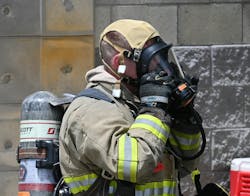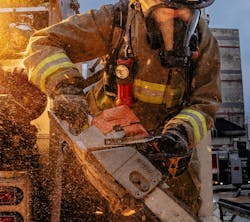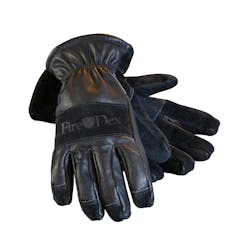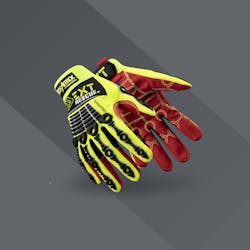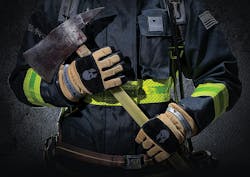If These Hands Could Talk: Sourcing Structural Firefighting Gloves
The process for selecting a structural firefighting glove isn’t as simple as it might seem. Most considerations involve adhering to NFPA 1971: Standard on Protective Ensembles for Structural Fire Fighting and Proximity Fire Fighting. Beyond that, equally important aspects must be considered. These include form, fit, function, durability and, yes, cost.
Hand/wrist injuries
The selection process for structural firefighting gloves is anchored in the NFPA 1971 standards. These guidelines serve as the benchmark for ensuring that the gloves upon which firefighters rely not only provide optimal protection and durability but also are capable of withstanding the intense conditions that are inherent in firefighting. As fires become increasingly complex because of synthetic materials, increased thermal decay and other factors, the standards illustrate the necessity for continual evaluation and adaptation of glove materials and designs. However, although NFPA 1971 sets a solid foundation, it also implicitly calls attention to the dynamic nature of safety requirements, urging manufacturers and safety regulators alike to engage in a cycle of innovation and reassessment. The intrinsic value of such rigorous processes lies not solely in compliance but in a broader commitment to safeguarding those who put their life on the line, suggesting that, while we adhere to established standards, we also must remain agile to emergent threats and advancements in protective technology. In essence, the selection process becomes an ongoing dialogue between enduring principles and progressive adaptation, to ensure that firefighters are equipped with gear that meets the demands of both present and unforeseen challenges.
Former CAL FIRE PPE working group member Josh Jansen tells us that the department endeavored through an extensive, three-year wear trial and study on gloves (structural and wildland) to determine the best organizational path forward. Throughout the study, it was determined that the majority of hand/wrist injuries were a result of firefighters not wearing their gloves because they were uncomfortable, lacked dexterity, fit poorly, were cumbersome and/or were the wrong size. After learning this, CAL FIRE decided to expend more money on gloves of the highest quality, which translated into the firefighters actually wearing their gloves, ultimately reducing injuries and burns.
Although not every agency can provide the same level of intense assessment as CAL FIRE can, all agencies can learn something from this exercise. Specifically, the department’s intent at the outset was to reduce injury and increase compliance with wearing structural firefighting gloves. This is a worthy endeavor for any organization.
Fit and form
The seemingly mundane task of donning structural firefighting gloves takes center stage in terms of effective fireground performance. Although often overlooked amid the extensive array of firefighting gear, the proper fit of these gloves reigns supreme not only for safeguarding the well-being of firefighters but also for ensuring their operational effectiveness.
The dynamic and unpredictable nature of firefighting requires dexterity and tactile sensitivity, which only can be realized fully when gloves fit as an extension of one’s own hands. A glove that doesn’t fit correctly isn’t merely an inconvenience; it poses significant risks, from reduced grip strength to slower reaction times, potentially compromising the safety of both firefighters and those who they swore to protect.
Yet, the notion of glove fit extends beyond safety. It encompasses injury prevention and enhances performance under duress, by providing confidence and allowing firefighters to perform such tasks as handling tools, navigating debris, and executing rescues with precision and efficiency.
It also is compulsory for agencies to provide a full selection of glove sizes that will be available to their teams, including those who have smaller hands.
Any organizational examination into how the fit of structural firefighting gloves affects these critical aspects reveals a fundamental truth: Glove fit is a linchpin in optimizing both firefighter safety and effectiveness in high-stakes scenarios.
The fit and form of structural firefighting gloves have been evaluated extensively for their effect on safety and operational performance. The research is conclusive. According to Hongwei Hsiao and his co-authors in “Firefighter Hand Anthropometry and Structural Glove Sizing: A New Perspective,” proper fit is critical in ensuring that these gloves provide both adequate protection from extreme temperatures and hazardous materials while also enhancing the manual dexterity that’s necessary for managing equipment and performing critical tasks.
Advancements in glove manufacturing focus on optimizing grip strength and tactile sensitivity without compromising the robustness that’s needed to withstand harsh environments. As noted in “A Study on Performance Evaluation Criteria for Safety Gloves for Forest Firefighting Crews” (Jae-Han Jeong et al, International Journal of Fire Science and Engineering, 2018), this delicate balance addresses a primary concern that’s raised by firefighters: Limitations in hand movement because of poorly designed gloves can impede firefighters’ ability to react swiftly and effectively in emergencies. Consequently, efforts to improve glove design consider not only the thermal and chemical resistance but also ergonomic factors that influence a firefighter’s capacity to navigate complex, emergent environments. Selecting the correct fit transcends conventional safety mandates; it directly correlates with firefighters’ ability to execute their duties with precision and confidence.
Durability
Beyond fit and form, the durability of structural firefighting gloves affects operational capability and, ultimately, efficiency. Durable gloves ensure that firefighters can perform their duties without distraction and frequent gear replacements. This is an important distinction. We all know the value of a well-fitting, well-worn glove.
Additionally, the longevity of firefighting gloves reduces costs that are associated with recurrent purchases and extends the usability span of these important pieces of PPE.
Agencies should examine how advancements in materials and design contribute to their protective capabilities and operational efficiency. In “Effect of fabric properties and glove structure on thermal protective performance of fire gloves under flash fire exposure” (Textile Research Journal, Sept. 2023), authors Lijun Wang and Tingyu Wang report that the selection of high-performance textiles that have thermal-resistance properties forms the foundation for developing gloves that can withstand intense heat while maintaining dexterity. International standards, such as EN 659, accentuate the significance of protective performance by prescribing rigorous testing protocols for durability and heat resistance.
The incorporation of innovative fibers and composite materials ensures that gloves not only provide immediate protection against fireground conditions but also endure prolonged exposure without degradation. We are seeing that innovations are focusing on ergonomic tailoring to enhance comfort without compromising safety. This allows firefighters to maneuver efficiently during use. This marriage of advanced materials with thoughtful design fosters a symbiotic relationship in which safety enhancements naturally align with operational needs.
The durability of structural firefighting gloves stands at the intersection of safety and operational efficiency. So, although current technological innovations continue to improve glove design, ongoing research is vital to adapt to evolving challenges that firefighters face worldwide. The throughput of information from the fire service to the designers of gloves must be encouraged and maintained.
The longevity of PPE not only is at the center of safety but one of economic and environmental sustainability implications. Firefighters operate in environments in which their protective gear must withstand constant exposure to extreme elements; gloves that maintain their integrity and do so over an appreciable span of service is of utmost concern. The effect of glove deterioration isn’t just an immediate safety concern; it also poses long-term operational challenges as frequent replacements strain budgets. As municipalities increasingly seek cost-efficient solutions, investing in highest quality gloves can reduce financial burdens by decreasing the frequency of purchases and repairs.
From an environmental perspective, longer-lasting gloves align with sustainability practices by reducing waste and minimizing the carbon footprint that’s associated with repeated manufacturing cycles. This has the focused attention of many appointed and elected officials. By demonstrating a reduction in environmental impact, agencies can contribute to broader ecological goals, providing durable gloves as not merely a component of safety equipment but as part of a sustainable operational ethos. If you ever were tasked with responsible disposal of PPE, you know that it’s no easy task.
Cost
Balancing cost with quality in the selection of structural firefighting gloves remains an intricate endeavor that directly affects firefighter safety and operational efficiency. The ergonomic and protective requirements of PPE, including gloves, places a nexus on the meticulous evaluation of materials that can withstand high temperatures and can provide dexterity, without compromising protection or incurring prohibitive costs.
When financial limitations dictate the availability of such vital gear, departments face daunting choices. It also should be emphasized that investing in suboptimal gloves to save costs can detrimentally affect firefighters’ mobility and overall performance in emergencies and lead to increased injury. Although economic constraints are real and persistent and aren’t going away, the consequences of opting for lesser quality will have unintended consequences. Prioritizing high-grade materials and designs that enhance form, fit, function, durability and longevity must be considered an investment in the safety and effectiveness of firefighting personnel. The dilemma of cost stresses the need for strategic decision-making that reconciles economic realities with the imperative of safeguarding firefighters.
Health and effectiveness
Moving forward, maybe we should recite this modification of an Alan Brunacini quote: Spend a lot to save a lot. One can’t overstate just how much this essential gear functions as a microcosm of the larger balancing act that fire departments must perform—juggling innovation, safety and fiscal responsibility. As we consider the numerous factors that influence glove selection, from material durability to cost-effectiveness, it should be evident that these decisions have far-reaching implications not only for firefighter health but also for operational efficacy.
PRODUCT SPOTLIGHT
Firefighting Gloves
Dex-Pro Structural Firefighting Gloves from Fire-Dex offer superlative dexterity, which gives firefighters the flexibility and protection that they need to be at their best on the fireground. The gloves are made with premium materials and are loaded with ergonomic features.
Extrication Gloves
Structural Gloves
The Fire Knight structural firefighting glove from Veridian is engineered with a PBI and Kevlar shell, a Gore CrossTech insert, a 3D finger design for superlative dexterity and a contoured knuckle guard. The revolutionary grab bar ensures effortless donning. Proudly made in the United States, the glove redefines durability and performance.
About the Author

Kristopher Blume
Kristopher T. Blume is the fire chief of the Meridian, ID, Fire Department and has more than two decades of fire service experience. He is an author, lecturer and independent consultant. Blume is a graduate of the Executive Fire Officer (EFO) program and is an instructor at the National Fire Academy. As a student of the fire service, he is focused on values-driven, mission-focused leadership for the profession. He is the author of "Carry the Fire: The Crucible of Leadership in the Fire Service".
